The Catacombs of San Francisco
- Address: Jirón Lampa y Ancash en el Centro de Lima a 5 min de la plaza de armas
- Tags:
 What to see Lima,
Lima,
Peru
What to see Lima,
Lima,
Peru
- Telephone: +51 1 4267377
- Website: http://museocatacumbas.com/
A visit to the catacombs of San Francisco in Lima
The Famous Catacombs of San Francisco in Lima:
Hi everyone! I hope that you're all well. I'm going to tell you that when I was a student at San Marcos, I always wanted to be a tourist guide and one day my dream came true, when I got to do my internship at the Casona, and the National University of San Marcos (the oldest university on the continent) which you can find by the university park where I had the opportunity to stay for almost three months.
There I was able to realise what I was most passionate about and that was colonial art and everything related to the centre of Lima. Gradually I began to walk more and more through the streets, going to the churches one by one and each time I was became more and more intrigued with everything I was able to find in the little streets from yesteryear. I remember leaving a street named Nicolas de Pierola and from there I found many French-looking houses, as well as the most characteristic city centre: the famous Balconies of Lima. Lima is a jewel in itself and nowadays on each street exists some legend, a historical fact and so many other things.

After being in La Casona of San Marcos, I applied to be a guide for four month in the Convent and Catacombs of San Francisco because it was the next step on the way to my vocational training. I had some memories of this place from when I was young as I remember that sometimes my school had brought me to this place and I had remembered things like the bones, the cloisters and their catacombs and I'd said to myself that one day I had to come back and so that's how it happened.
One afternoon, I met with some university friends and I found so many things that I couldn't remember as a child such as the Mudejar style dome, the paintings of Peter Paul Rubens, some balconies inside the town hall and there I said "Jesús, you have to go in there! " and that was how I begin my story in one of the most visited museums in the centre of Lima.

I tell you, dear readers, that the convent was the first monument in the centre of Lima to be declared a World Heritage Site by UNESCO in 1989.
In those times, Peru was still living in times of terrorism and it was dangerous to even go out into the streets because one could be met with car bombs in any part of the city, as well as blackouts and many other things. I was only a baby in those days, barely 3 years old, so obviously I don't remember anything but my city's history is something I am most passionate about and I can tell you that the Convent and Catacombs of San Francisco has been one of the most enriching experiences that I've had in my university life and today I remember it fondly because I learnt so much.
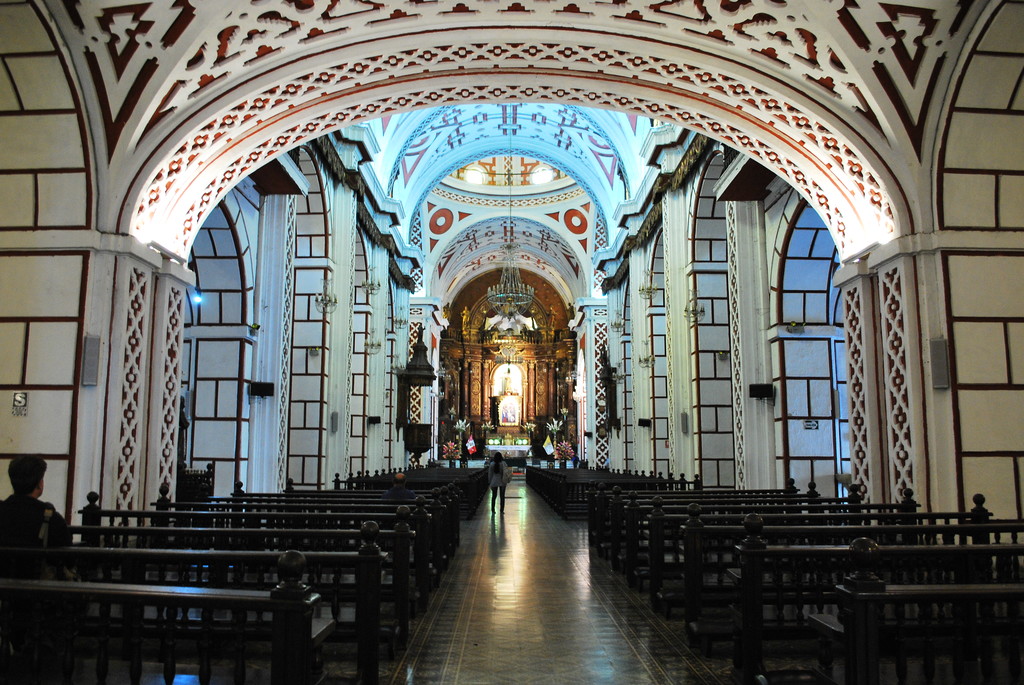
I learned to be as surprised as the visitors when I saw the colonial paintings, I learned to understand why the people in colonial times decided to burying themselves under the churches and not in the cemeteries that we know today, and I learned to know about the alcoves, capitals, images, towers, church buildings, types of art and many other things.
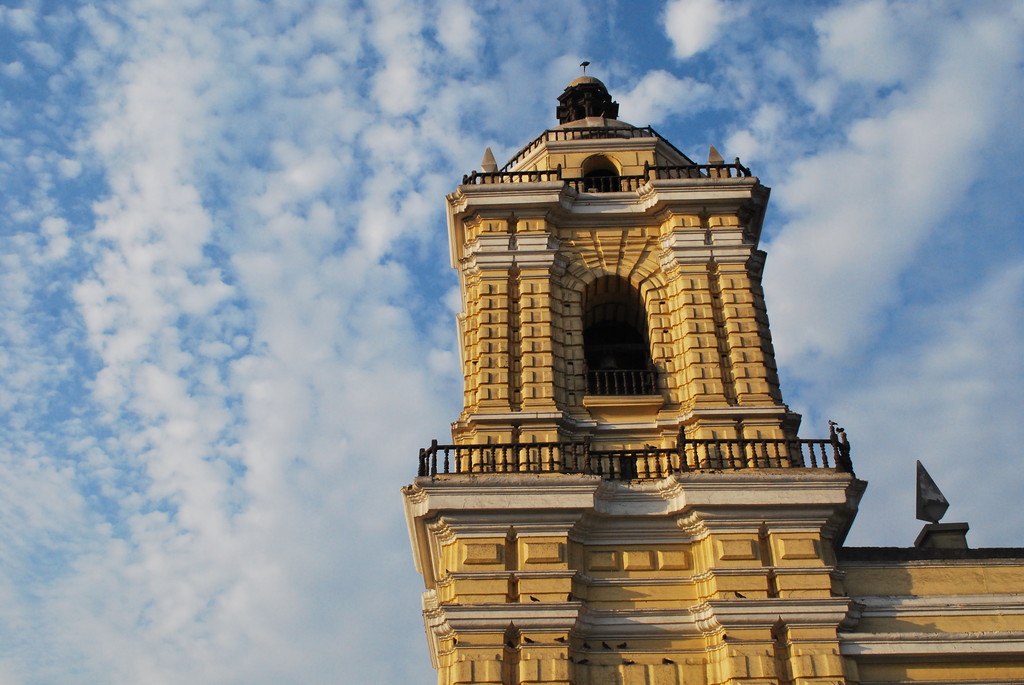
Perhaps they think that I follow the Catholic religion but I tell you no, today I consider myself agnostic. I don't believe in religions and I'm still not convinced that God exists even though I've had moments in which I've wanted to believe and I reckon that the passing of time and maturity will help me understand the reality of man and their surroundings a little more, however I appreciate what our ancestors have left us and the different stages Lima has gone through.
Today, I tell you, Lima, my city, has gone through thousands of pre-Hispanic years before the arrival of the Spanish to the Americas and that's just by mentioning the city Caral which has almost 5000 years of history, the Lima went through a glorious colonial stage, being the most important city of its time throughout the continent and it is precisely in those times when the different religious orders of the city begin to form and Lima begins to grow tied to religious art, a city of cathedrals, of saints like Saint Jude the Apostle who is found inside the monastery and who is considered the Patron Saint of the Impossible and Work, because as I was telling you all, colonial Lima can be summed up in many museums but I'll always keep the Monastery and Catacombs of San Francisco close to my heart, one of Lima's most glorious monuments that won't disappear from the city.
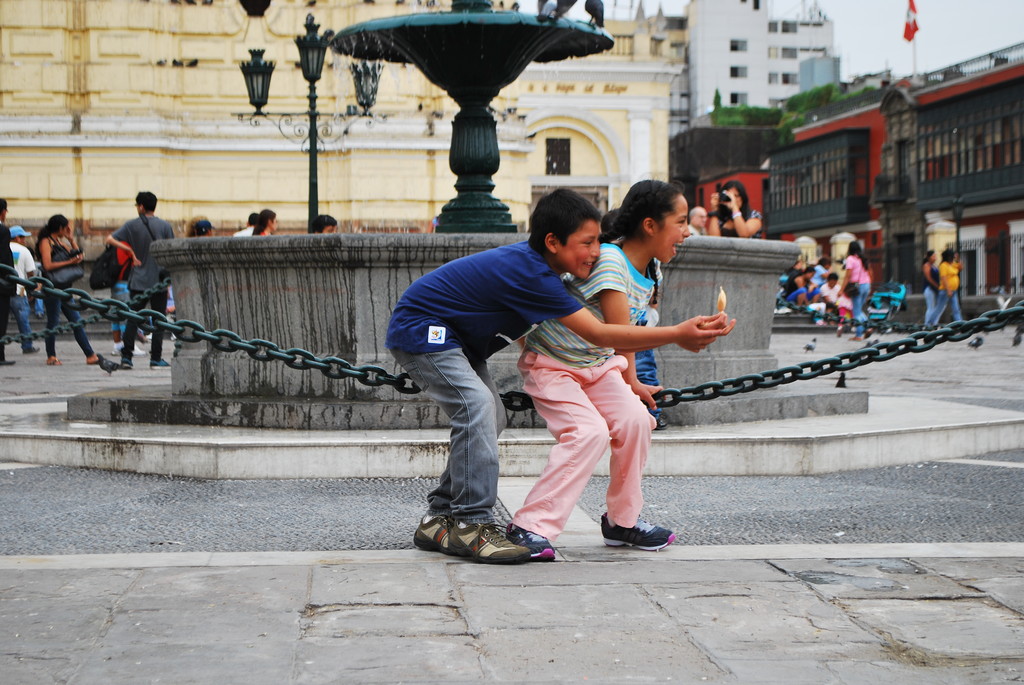
On the other hand, Lima has so much more. As many of you know, Peru is a free and independent country and it was at the beginning of the 20th century that Lima began to change and give way to new life, for example the construction of the Plaza San Martin, a place that I've dedicated a publication to because of the curious information that it has provoked in me.
In truth I can tell you that if told me to choose between so many things that exist in Lima's centre, I would not know what to say because I love this church with the yellow facade renovated again and again due to the fact that Lima is located between the most active tectonic plates in the world and because there are so many earthquakes, it would be impossible to keep everything standing up.
Lima has been able to go ahead with materials that are going to surprise you and although I shouldn't tell you this, if you blow on the monastery walls or on the museum walls, it'll feel as if they're empty and it's because many of the houses built in Lima's city centre are reeds, lime and pebbles, which mean that these buildings can resist the famous earthquakes, such as the earthquake in 1746 where there was even a tsunami in the port of Callao and part of the land remains under sea's currents to this day.
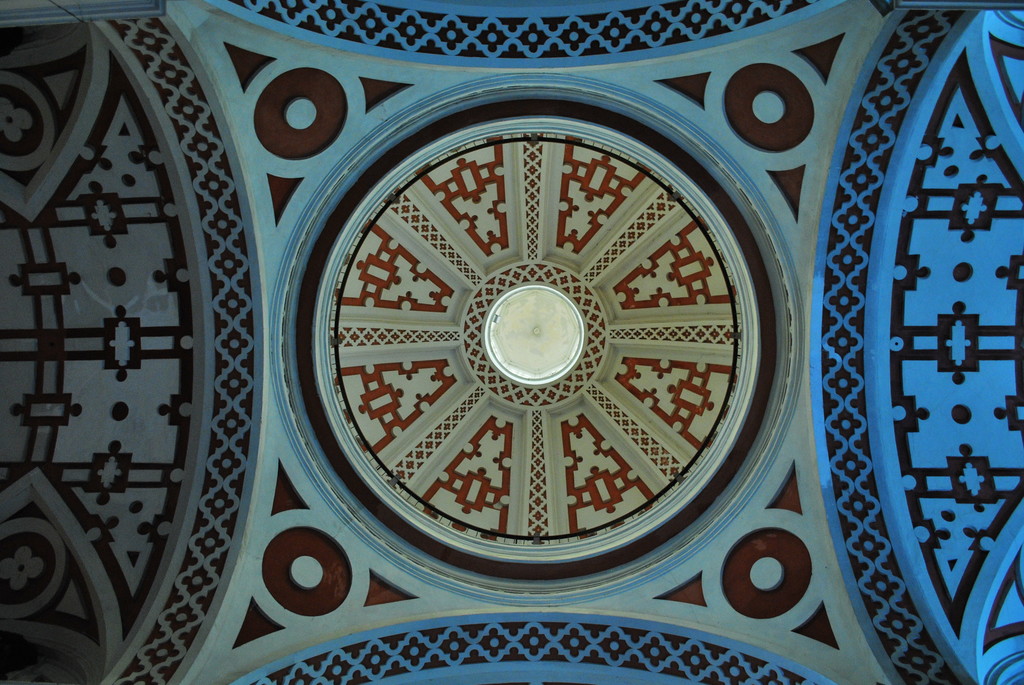
I still remember my training days which were taught by a man called Pedro, who had spent years at the museum, as well as Mrs Rossi and Fray Martín who blessed us when we entered the museum. Also, the entry to the museum isn't through the church door, but through the part which would be the entrance to the cloisters. So you can see it better, the next image will show you where the three marked white doors are. In the main door, you'll find the entrance to the monastery. There on the right hand you will find a small desk where you pay the admission to the museum with the included guide. From the moment you enter you will be amazed by all the art because within the museum there is a sculpture of the Virgin of the Immaculate Conception made of of marble. In addition, there is a picture that implies that it was an altarpiece in the religious life of Christ:
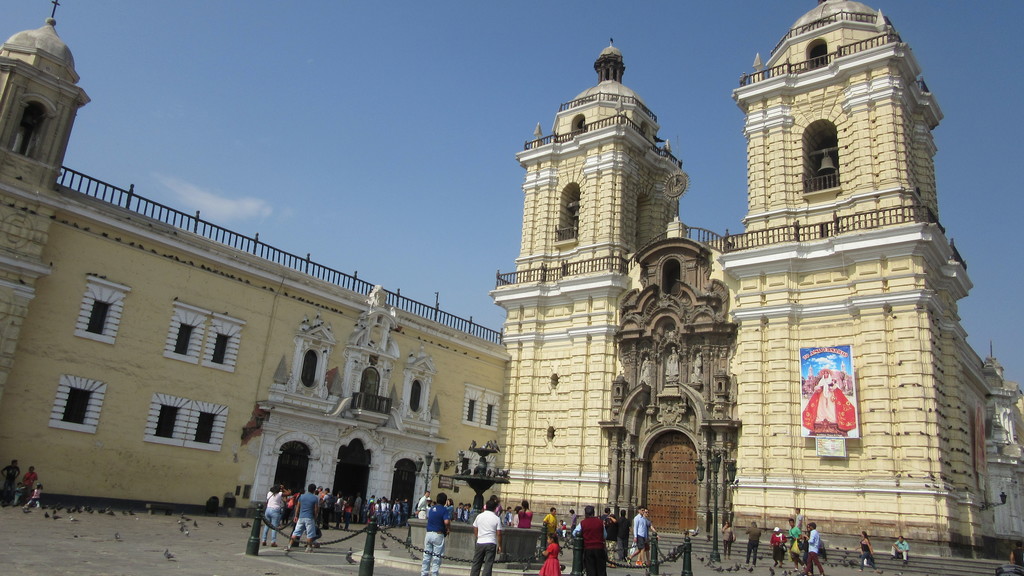
The entrance to the museum is known as the Ante Portería (the first entrance into the museum) and from there you can go and take in everything you see when walking round the place. The painting in the entrance, that I have already mentioned, shows you one of the most recognised paintings from the Colonial time. This is the Angelino Medoro. These paintings show us the passion of Christ and his crucifixion. Also, for the most part, on the floor of the monastery, you will find the luxurious Sevillian tiles which were mainly brought in from Spain and they date back to the 17th century: a decoration that makes the Monastery of San Francisco one of the most loved in Lima.
Why is the Monastery of San Francisco important?
Basically, the museum is important because it possesses a valuable religious art collection and the Church of San Francisco has the rank of a minor basilica granted by Pope John XXIII in 1963. Here you can find pictures of Spanish and European artists like José de Rivera and Flemish paintings by Peter Paul Rubens. Additionally, the main attraction in this museum are the bones and its incredible catacombs.
I have to tell you that the origins of the Franciscans and the museum date back to the year of 1546. In those times the church didn't have the luxury that we see today, instead it was very small and the original no longer exists. Over the church, gradually they constructed what we can see today and on the main facade, you can see in the centre of the alcove the virgin of the Immaculate Conception. Also, as you will see many a time round the museum, the Franciscan coat of arms, which is made up of two hands that cross over and one of these would be the hand of the founder, San Francisco de Asis and the other would be the hand of Jesus Christ. In other representations, you can also see a coat of arms with 5 marks which represent the wounds that San Francisco de Asis received according to the Order.
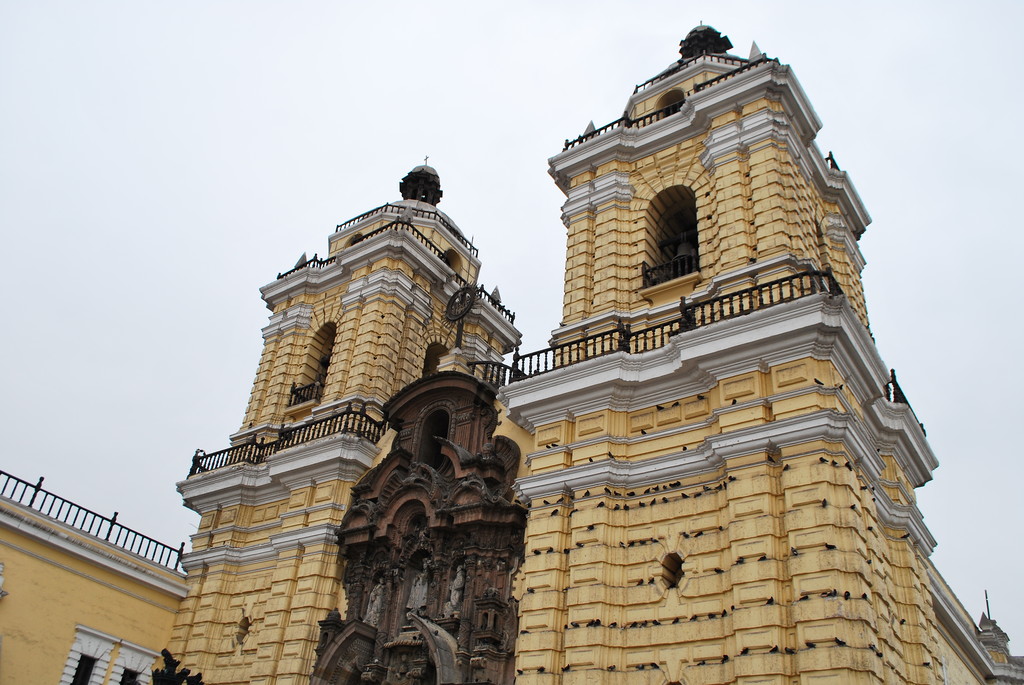
What's more, the majority of people who enter the museum, only want to see the Catacombs, yet they are surprised when they begin the tour because they realise that the monastery has has so much more than just the bones and underground passages beneath the church. They're in a state of constant surprise when they see what more the place has to offer. In addition to being a must in Lima's centre, I would say that it is a lot nicer than the Cathedral Basilica of St. John the Apostle and Evangelist, which is found in the Plaza de Armas. I have also been here many times and I have also dedicated another publication to this place so you can read it but, firstly, let's carry of with San Francisco of Lima!
As I said initially, the Monastery of San Francisco was the first monument inside the city of Lima which was declared a World Heritage Site by UNESCO and so it gives the monastery a big advantage over other religious centres in the city. However, when you go, you realise that there are many entrances to this part of the museum and the church because there is also another little church: Basilica of Our Lady of Solitude and the Iglesia del Milagro which still aren't open to the public due to terrible fire and damage to its insides over many years. On the other hand, inside the small plaza of San Francisco they have carried out theatrical works like "La Vida es Sueño (Life is a Dream) by Pedro Calderón de la Barca. I remember setting up a big stage that night and it was a beautiful piece of work where you saw the life of Sigismondo. A very famous scene in which the character says the famous literary phrase:
"¿Qué es la vida? Un frenesí.
¿Qué es la vida? Una ilusión,
una sombra, una ficción,
y el mayor bien es pequeño;
que toda la vida es sueño,
y los sueños, sueños son"
"What is life? Madness.
What is life? An illusion, a shadow, an invention and the greater good is small;
all of life is a dream, and dreams, dreams they are"

If I relate it to the museum I can say that his art is also an exquisite dream of canvases and mysteries that I will tell you little by little. In that presentation of "La via es sueño" I had the opportunity to go in for free and from there I could see with greater conviction the lattice-work patio of the church. As well as for the tourists, there is so much culture for people of Lima. Today Lima is one of the most visited cities in Latin America, no only because of its art but because of its excellent food and for hosting different congresses and events.
I can also say with pride that Lima is considered the gastronomical capital of South America. An emblem that makes us Peruvians value more and more out legendary past. However, let's carry on with the museum! I'm getting carried away with other part of the city that I love so much.

How much does it cost? Is it worth it?
So, if you're a student you can visit the catacombs at the Monastery Museum for only 5 Soles. There is a tour which is about 40/50 minutes on which you discover many facts about religious art and the catacombs of Lima where, to your astonishment, there were more than 25, 000 people buried during the colonial period. Imagine that!
The tours are only given in Spanish and English. Normally if you speak the Spanish language you'll only have to wait about 10 minutes max before a tour which would start in the "Sala Porteria". There you can find some waiting seats and you can take a moment to appreciate the wooden image of Christ's crucifixion made anonymously, which dates back to the 17th century. Also, there is another huge painting that decorates the walls and and the Sevillian ties on the skirting boards, donated by Pedro Jimenez Menacho, who like his family is also berried under the monastery in the incredible, most visited catacombs in Lima.
How do I get to the catacombs?
There are various ways to get to the monastery because the main avenue is located just one block from Avenida Abancay where you can also find other museums such Museum of the Inquisition and Congress and other picturesque places like the Chinese district. The only bad thing about Avenida Abancay is that it's well travelled and so there is a lot of traffic. Therefore, the best alternative is to use el metropolitano, Line C. Despite there being many people at rush hour, Lima has many different modes of transport, at different prices. The price for the metro starts from 2. 50 Soles one way and to enter you should have previously bought a metro card which are sold in any station around the city. Another option is to take the blue buses but you'll have to walk a little more because it'll drop you buy Avenida Tacna.
A little additional information is the in front of the small plaza of San Francisco, you'll find the Tribunal Constitucional, la Casa de las 13 puertas and the back of the Muralla Park, places that I recommend you visit! Sometime before passing the museum of San Francisco and by Azángaro street, there are some shops where you can find the tastiest churros in Lima's centre, which I used to buy when I left my guide to sweeten my afternoon, for only 2 Soles and they put them in little carrier bags. They're so big and tasty. Now I'm hungry thinking about the sweets you can find in Lima!
Why are there people buried under the Churches?
In that era, it was believed that to be closer to God after death, you were buried beneath the Churches and because of this many of Lima's elite were buried there until the time of Independence in 1821 when the liberator Don José de San Martín closed the cemetery and opened another one which is the Cementerio Presbítero Matías Maestro en Barrios Altos.

I'm not kidding, I'm serious! You know that Lima is a city that had a lot of churches in the Colonial period? and that the first Saint of America is from Lima? So, I'm talking about Santa Rosa de Lima, although she is connected to the Dominican Order. Church of Santo Domingo
Is it true that the Museum is known as la iglesia de las palomitas?
That's right. Some people from Lima know this church as the church of the pigeons because you'll find them on the plaza, and these little animals inadvertently have become part of our heritage.
Here's the picture:

What's the tour like? Why should I go? Can I take photos?
Aaah, unfortunately you can't take photos. However, here I've downloaded some photos from the museum's website and there are some that I took when I guided my friend once. The rest of my photos are on my computer in Lima and at the moment I can't upload them so let's carry on...
Sometimes when you enter the catacombs, you'll find guides that aren't necessarily from the Museum, permit you to take photos inside the place. You can take a quick photo before the group arrives, but keep in mind to do it without flash.
The tour of the catacombs goes in a "U" shape. This lasts approximately 15 minutes and they will always tell you that if you're claustrophobic, it's better not to enter. The smell of the catacombs is a strong one, almost like a salty residue due to the materials that they're made from.

I've made you a list of things that'll help you quickly get to know this museum:
- Sala de Porteria - Porter's Room
- Sala Profundis - Profundis Room
- Pinacoteca - Art Gallery
- Biblioteca - Library
- Reflectorio - Dining Room
- Claustro - Cloisters
- Sacristia y antesacristia - Sacristy and Pre-sacristy
-Coro - Choir (where they recite beautiful choral songs)
- View of the Church from the second floor in the Choir
- Catacombs
When you go, they'll make you see the Mudejar style dome in the main staircase (if you listen, you can hear a strange noise in the roof, though don't be scared, they're herbivorous bats). Then, they'll guide you to the Franciscan's library which looks like a library from Harry Potter (the guides don't actually say that but if you look, you'll see in the photo) and there are many books of different languages including latin, many of which aren't used nowadays. In the roof of the library, you can see some Teatina windows which lit up the monastery in the colonial period, despite there being no electricity. This library has more than 25. 000 volumes from colonial times.
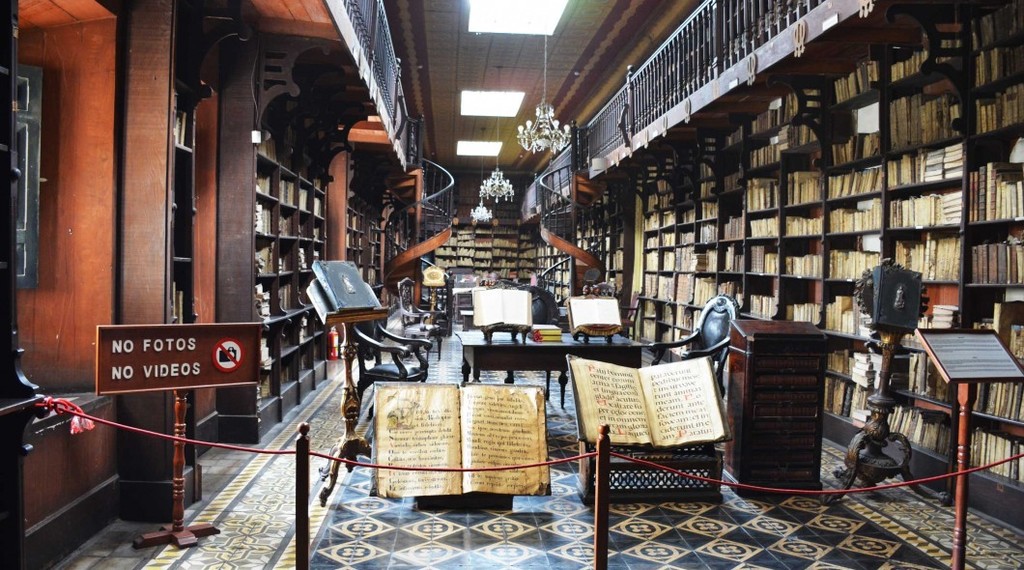
The Franciscan's library
What brings many visitors, and something I'm always asked about as a guide, were these huge books that are at the front of the previous photo. So, these books are known as the Choral books and they were used by the Franciscans in liturgical ceremonies in the monastery choir which can by found on the second floor. Then, passing by the library, you're going to see a square room where you'll see a beautiful wooden sculpture with different people from the Order. In the middle there is an image of San Francisco de Asis with Santo Domingo, giving the embrace of Peace.
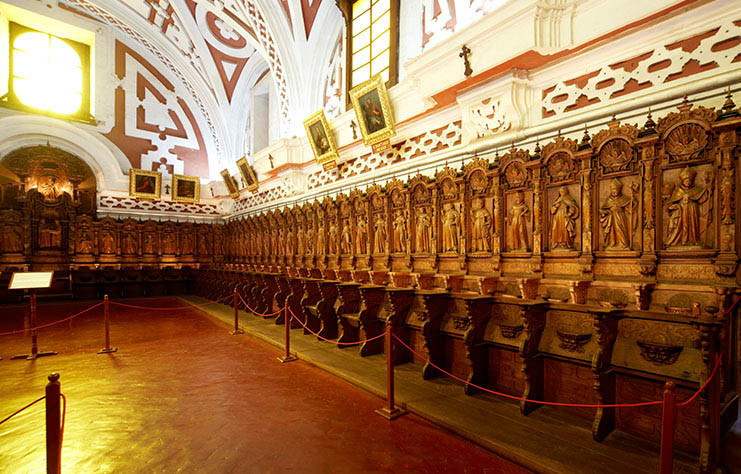
From the top part of the choir you can learn over and see the lower part of the church which is constructed in the shape a Latin cross. If you look at the ceiling, you'll find that the colours are predominantly white and a bright red, in the Mudejar style, which is also known as Moorish style.
On the right hand side of the choir, there is a grand piano which is only for show, but they say that it still works if a franciscan gets on the back and starts pedalling as if it was a bike. I remember that this was something that attracted a lot of tourist attention.
What animal is in the centre of the table of the painting?
Another thing that attracts a lot of attention is a painting of the last supper in a round shape. You'll also see in the middle of the table, a little animal that is well known to all Peruvians: the famous guinea pig on the plate, a typical Peruvian dish "cuy chactado". Through this painting we also see an influence from Spanish and Andean styles. I like this painting a lot because the people are always surprised. What about you?
The painting is found inside a room known as the refectory. This place was where the Franciscans ate and also today, at the back of this part of the museum, the monastery continues serving free food to those in need. Usually when you go into this room, you'll smell the food that is coming out of this dining room.
Here I present the mega painting. Go to the museum so you can see how big it is :) is located in the refectory, the place where the Franciscans ate.

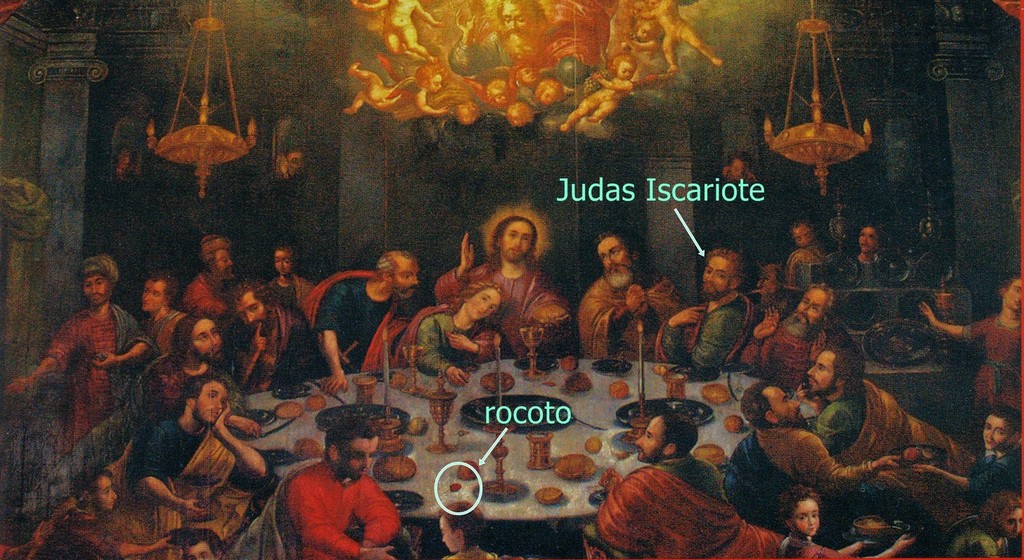
This painting attracts many visitors, not only because you can see Jesus with his apostles, but also because there are different people around him, serving at the table. If you look carefully towards the sides, for example the left hand side, you can see an image of a couple that have absolutely nothing to do with the last supper. This is still a mystery and if that wasn't enough, in this painting you can see in a window the face of the devil, who is next to Judas, who we all know betrayed Jesus. Additionally, there are also children serving the table and they represent purity and there is a dog that represents fidelity towards man. This canvas was painting by Diego de la Puente in the 17th century.
Inside the refectory, you can also find some painting that represent different people from the tribes of Israel like Jacob and his twelve brothers.
Who are the benefactors?
In the colonial period, benefactors existed, people that gave money to the Franciscan order so that when they died, they could be buried in the private crypts with their family. They explain this to you on the tour of the monastery. When you are in the cloisters and they tell you that below are buried people, you can't help but say "what?! " Also you will see a silver platter weighing one thousand tons of the Holy Saint Judas Thaddeus, who is considered the Pattern of work and of the impossible.
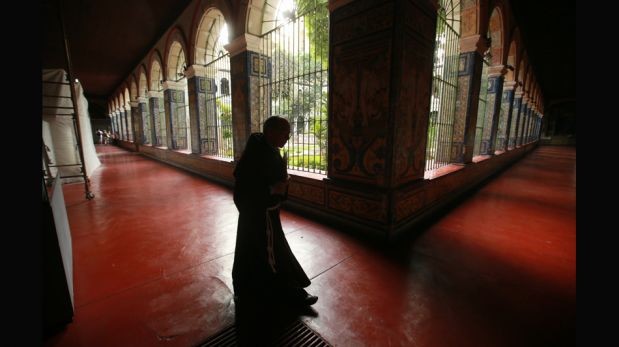
Meet the Sala Profundis and the collection of Flemish paintings:
Dear friends, after the painting of the last super, the place that I liked the most was the Sala Profundis. Here you can see a collection of the devoted Jesus, made by Peter Paul Rubens and his Flemish painting, in which the chiaroscuro stands out. Also, in this room there is a balcony inside facing the bottom, which comes from the old Government Palace. This balcony is made with wood from Central America. In addition to having in the central part, there was a custodian of gold brought from Cusco and on the top an ivory christ made with the bones of the elephants of the Philippines.
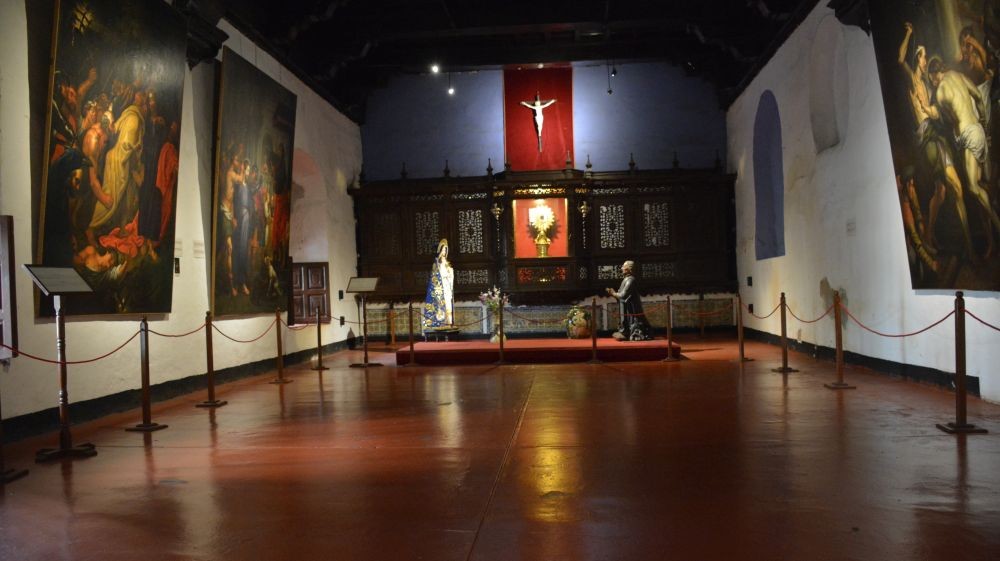
Another thing that catches a lot of attention is that inside the centre of this room is a family crypt exclusive to one of the benefactors and his name was Luis de Castilla Altamirano. As a way of decoration you will find that there is a skull and bones in sight but it was not always the case. Since colonial times the bodies were in their drawers and covered under this hall.
I remember that every week we took the tours of the place to make sure that no one was taking photos or damaging the canvases, just being alone in this room was a breath of tranquility. There is also another picture that grabs your attention and that is the one of Jesus on a donkey and the donkey looks as if it's following round the room. When I gave tours, I could only explain this particular detail when there weren't many groups in the room because I had to give everyone the opportunity to be able to appreciate the paintings, so that they know when they enter the room, they'll also have that strange feeling that the donkey is watching them.
The painting of the Franciscan family:
Inside the room known as the Pre-sacristy, you'll find a spectacular painting in which you'll see the genealogical tree of the Franciscan Order. This begins with San Francisco de Asis as the tree's roots and in the upper part of the image is the virgen of the Immaculate Conception. Just below this painting there is the basement, which is where you enter for the catacombs.

What's more, before passing this side of the Pre-sacristy, you'll see a door that would have gone unnoticed until the guide explains that behind that door, there are still Franciscans in their cloisters, because despite it being a museum, there are still Franciscans that live inside the monastery like Fray Martín, who I mentioned at the beginning and is the leader of the museum.
There is also a funeral carriage which is used to transport the coffins to the Presbítero Maestro cemetery. When it began to work, the catacombs were closed.
Sacristy and his sculpture converted to Jesus:
Next to the Pre-Sacristy, is the Sacristy. You can see wooden boxes that were used for the Franciscans to put on their clothes to offer the Holy Mass. Also in the upper part you will see different carved martyrs of wood and bathed with gold leaf. In the middle of it, you'll find the image of Jesus Christ which has a story because the say that originally the image was going to be that of the Virgin of Immaculate Conception but in the end it became Jesus, but how do we know? When you go to the museum, look at the lower part with Jesus' feet. It looks as if it were a dress besides there also being a cherub, which were typical of the representation of the Immaculate Conception.
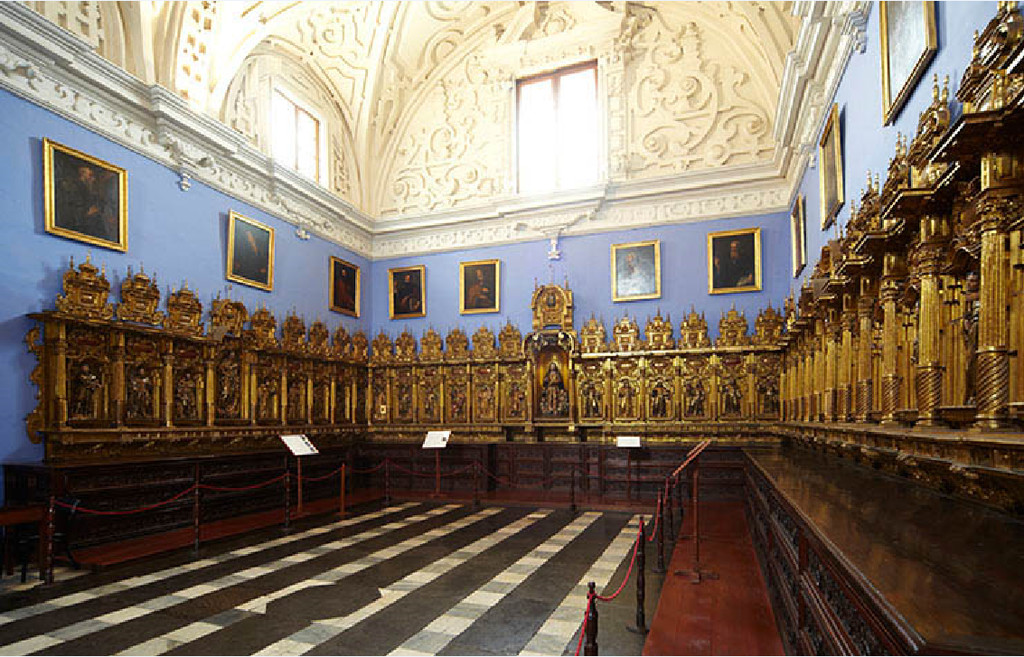

After seeing the sacristy one you can now prepare yourself for what most visitors want to see: the catacombs of San Francisco de Lima!
And the catacombs? At what point are you going to tell me about the catacombs?

As I've already told you, the last thing that you'll see on the tour are the catacombs of San Francisco. As you enter, they'll explain that the columns are made with egg white and guano bird droppings, as well as lime and pebbles. "With what? " you might say. What if there was an earthquake? We would die in one of these? Well, in case of an earthquake, you're actually in a very safe place (although don't be scared if an earthquake actually happens during your visit).
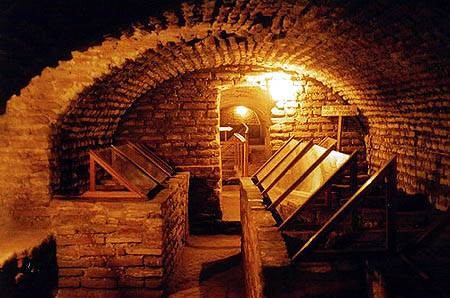
The entrance to the catacombs is on the left hand side and you go out on the right hand side. Something that people keep asking is, do people continue to be buried in this place or not, what do you think? How much do you want to bet? Well, the answer is yes, now people can still be buried but only those who belong to the order.

The Franciscan brothers have an exclusive crypt for themselves where the public can not enter but on some occasions, when closing the Museum, my guide friends and I enter them. In truth it is not a sinister place like the catacombs but there are crypts with the names of each one of the Franciscans that decided to continue on after death in the convent, resting in peace.
When you go through the catacombs you will find in the ceiling some little squares that let you see into the church, which would be the floor of the museum. From one of those squares one can see the Virgin of one of the altarpieces for example.
As I've already said, in the catacombs there are more than 25. 000 people buried. There are some wells, like the following, more than 15 metres deep with pure bone, but I do want to clarify that they don't think that the dead were torn apart so that they look like this, the arrangements you'll see are distributions made during the research process in addition to the electrical installations that today illuminate the passages.

Many stories are told of the catacombs that for example there was a secret road that connected with the Government Palace in the Plaza de Armas, but so far nothing has been found. So they are just urban legends that have been woven inside of the most visited catacombs of Lima, since there are many more in the city but the only one open to the public is this one.
The anti-seismic well of the catacombs:
Currently the bones are distributed by their forms and what is most striking is a well known ossuary where they are said to absorb seismic waves in case of an earthquake (at least that's what I was told when I took my guidance course there).
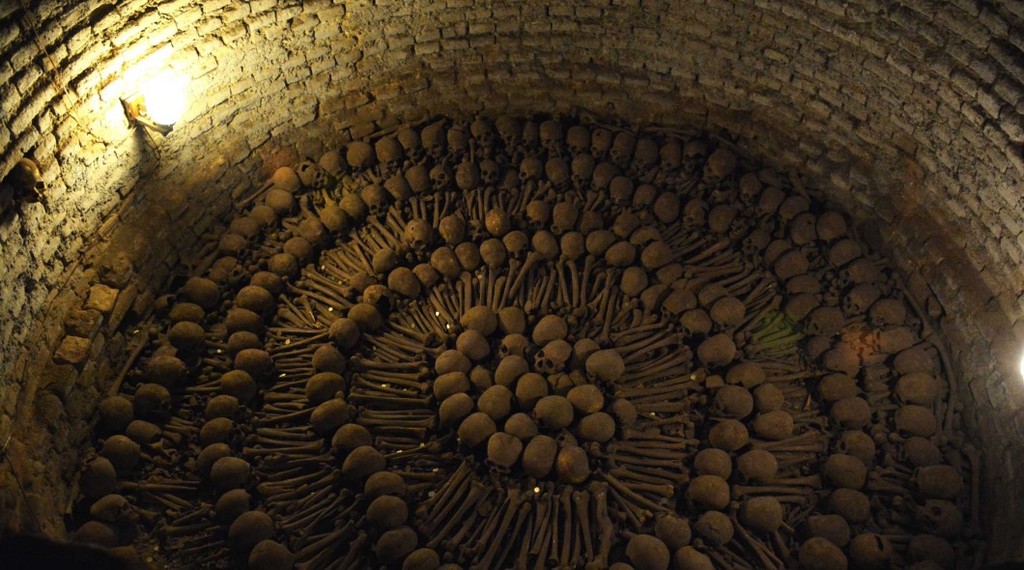
I also want to tell you that inside the catacombs there is an exclusive room for Fray José Francisco de Guadalupe Mojica, who belonged to the Franciscan religious order and who was also a great actor and singer of opera music and also starred in some Hollywood movies. Some Mexicans who know about his life come exclusively to see this room even though the space is not so big.
If you want to listen to one of his songs, you just need to click here and go to YouTube.

If you want to buy a souvenir on the way out, the they sell some postcards for everyone. As I told you the museum opens every day and is a must stop for all architecture lovers and visitors to Lima. :) Thanks to it Lima was considered a World Heritage Site :) oh yes!
And at what blessed moment will you tell me if the place is haunted?
It's not! There aren't any ghosts. In all my time there I was never tormented by one and I want to carry on believing that. Don't take away that illusion! I remember that once on the day of the dead, we left a bag of sweets on the bones for the dead. I don't remember well what we did with the bag but here is a picture of those who ate (I say... ) Forgive the tour guides of the time.

Bonustrack:
If you are interested in being part of the museum's guiding group, every four months the monastery selects a group of tourism students to be guide groups from Monday to Friday or Saturday and Sunday. I was there and it was an enriching experience since then I've learned to value religious art a lot more and I love to see the faces of the surprised visitors when they see the catacombs and the art.
Bonus pictures: My friend Joris and I on the second floor of the cloister. If you go there and walk around, you will see that due to the seismic shaking the columns lean towards one side. What are you waiting for? Go and see the museum!
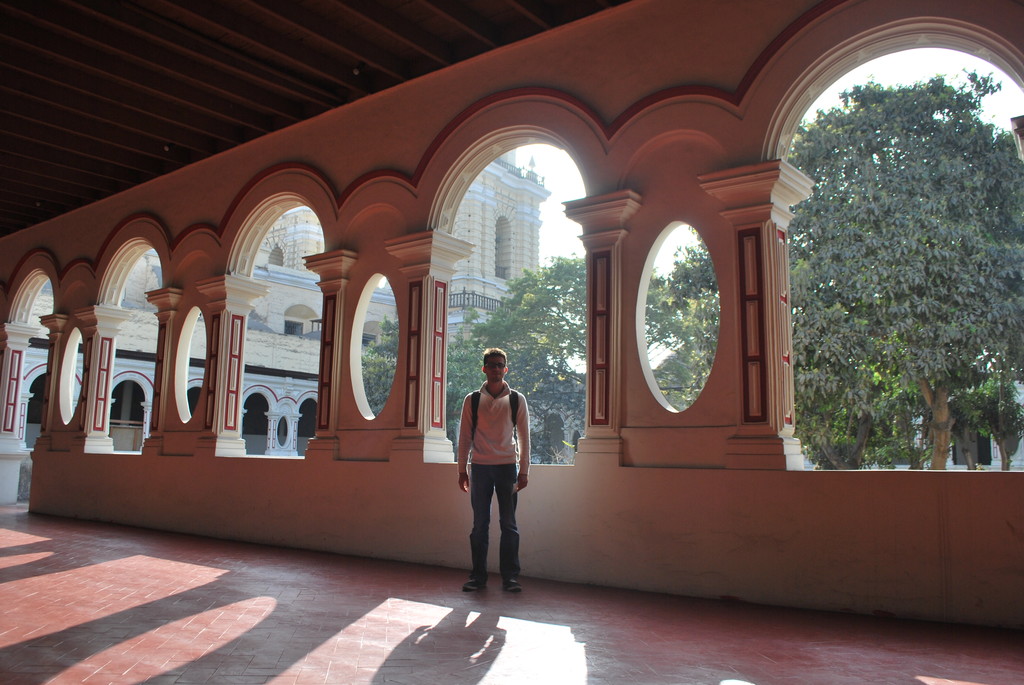
Until next time! I hope you like the tour and experience, see you soon! and thank you very much for reading my experience about one of the best museums in Lima.
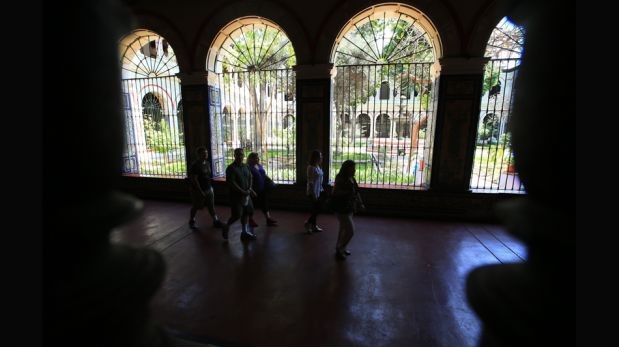
Photo gallery
Content available in other languages
Rate and comment about this place!
Do you know The Catacombs of San Francisco ? Share your opinion about this place.
















































